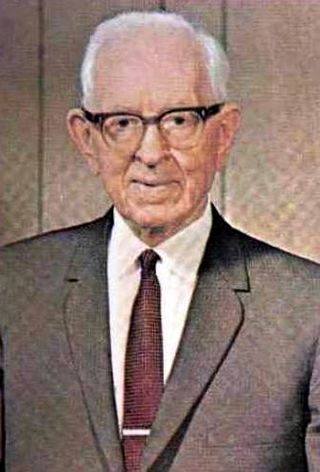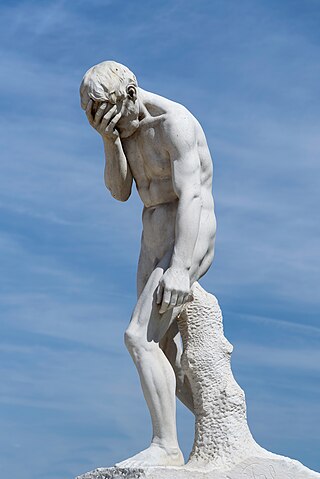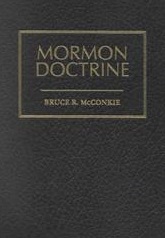In Mormonism, the Melchizedek priesthood, also referred to as the high priesthood of the holy order of God or the Holy Priesthood, after the Order of the Son of God, is the greater of the two orders of priesthood, the other being the Aaronic priesthood.
Early Mormonism had a range of doctrines related to race with regards to Black people of African descent. References to Black people, their social condition during the 19th and 20th centuries, and their spiritual place in Western Christianity as well as in Mormon scripture were complicated.
In the Latter Day Saint movement, an apostle is a "special witness of the name of Jesus Christ who is sent to teach the principles of salvation to others." In many Latter Day Saint churches, an apostle is a priesthood office of high authority within the church hierarchy. In many churches, apostles may be members of the Quorum of the Twelve and First Presidency of the church. In most Latter Day Saint churches, modern-day apostles are considered to have the same status and authority as the Biblical apostles.
During the history of the Latter Day Saint movement, the relationship between Black people and Mormonism has included enslavement, exclusion and inclusion, and official and unofficial discrimination. Black people have been involved with the Latter Day Saint movement since its inception in the 1830s. Their experiences have varied widely, depending on the denomination within Mormonism and the time of their involvement. From the mid-1800s to 1978, Mormonism's largest denomination – the Church of Jesus Christ of Latter-day Saints – barred Black women and men from participating in the ordinances of its temples necessary for the highest level of salvation, prevented most men of Black African descent from being ordained into the church's lay, all-male priesthood, supported racial segregation in its communities and schools, taught that righteous Black people would be made white after death, and opposed interracial marriage. The temple and priesthood racial restrictions were lifted by church leaders in 1978. In 2013, the church disavowed its previous teachings on race for the first time.

Joseph Fielding Smith Jr. was an American religious leader and writer who served as the tenth president of the Church of Jesus Christ of Latter-day Saints from 1970 until his death in 1972. He was the son of former church president Joseph F. Smith and the great-nephew of Church founder Joseph Smith.

Bruce Redd McConkie was a member of the Quorum of the Twelve Apostles of the Church of Jesus Christ of Latter-day Saints from 1972 until his death. McConkie was a member of the First Council of the Seventy of the LDS Church from 1946 until his calling to the Quorum of the Twelve Apostles.
This is a timeline of major events in Mormonism in the 20th century.

The curse of Cain and the mark of Cain are phrases that originated in the story of Cain and Abel in the Book of Genesis. In the stories, if someone harmed Cain, the damage would come back sevenfold. Some interpretations view this as a physical mark, whereas other interpretations see the "mark" as a sign, and not as a physical mark on Cain himself. The King James Version of the Bible reads "set a mark upon Cain".

Alvin Rulon Dyer was an apostle in the Church of Jesus Christ of Latter-day Saints and served as a member of the church's First Presidency from 1968 to 1970.
Joseph Fielding McConkie was a professor of Ancient Scripture at Brigham Young University (BYU) and an author or co-author of over 25 books.

In the Latter Day Saint movement, the great and abominable church is a church described in the Book of Mormon and other revelations by Joseph Smith. The great and abominable church is identified as being synonymous with the Whore of Babylon described in chapter 17 of the Book of Revelation. Although many Latter Day Saints have associated the great and abominable church with the Catholic Church, official publications of the Church of Jesus Christ of Latter-day Saints have discouraged this interpretation.
Assistant President of the Church was a position in the leadership hierarchy in the early days of the Latter Day Saint church founded by Joseph Smith. The Assistant President was the second-highest authority in the church and was a member of the church's governing First Presidency. As President of the Church, Smith appointed two men to serve in the position of Assistant President. After Smith's death, most Latter Day Saint denominations discontinued the position of Assistant President of the Church.
In the Church of Jesus Christ of Latter-day Saints, the Council of the Church may be the chief governing body of the church which holds the power to make the final decision on any spiritual matter that will affect any member of the church. Its existence and status are uncertain, and the body has not been formally convened since the presidency of John Taylor. The Council of the Church is sometimes confused with the Common Council of the Church.

The 1978 Revelation on Priesthood was an announcement by leaders of the Church of Jesus Christ of Latter-day Saints that reversed a long-standing policy excluding men of Black African descent from ordination to the denomination's priesthood and both Black men and women from priesthood ordinances in the temple. Leaders stated it was a revelation from God.
The Church of Jesus Christ of Latter-day Saints takes no official position on whether or not biological evolution has occurred, nor on the validity of the modern evolutionary synthesis as a scientific theory. In the twentieth century, the First Presidency of the LDS Church published doctrinal statements on the origin of man and creation. In addition, individual leaders of the church have expressed a variety of personal opinions on evolution, many of which have affected the beliefs and perceptions of Latter-day Saints.
From 1852 to 1978, temple and priesthood policies in the Church of Jesus Christ of Latter-day Saints prohibited both Black women and Black men from temple ordinances and ordination in the all-male priesthood. In 1978, the church's highest governing body, the First Presidency, declared in the statement "Official Declaration 2" that the restriction had been lifted. Between 1830 and 1852, a few Black men had been ordained to the Mormon priesthood in the Latter Day Saint movement under Joseph Smith.

The President of the Church is the highest office of the Church of Jesus Christ of Latter-day Saints. It was the office held by Joseph Smith, the church's founder. The church's president is its leader and the head of the First Presidency, its highest governing body. Latter-day Saints consider the president of the church to be a "prophet, seer, and revelator" and refer to him as "the Prophet", a title that was originally given to Smith. When the name of the president is used by adherents, it is usually prefaced by the title "President". Russell M. Nelson has been the president since January 14, 2018.
In the past, leaders of the Church of Jesus Christ of Latter-day Saints have consistently opposed marriages between members of different ethnicities, though interracial marriage is no longer considered a sin. In 1977, apostle Boyd K. Packer publicly stated that "[w]e've always counseled in the Church for our Mexican members to marry Mexicans, our Japanese members to marry Japanese, our Caucasians to marry Caucasians, our Polynesian members to marry Polynesians. ... The counsel has been wise." Nearly every decade for over a century—beginning with the church's formation in the 1830s until the 1970s—has seen some denunciations of interracial marriages (miscegenation), with most statements focusing on Black–White marriages. Church president Brigham Young taught on multiple occasions that Black–White marriage merited death for the couple and their children.

Teachings on the biblical curse of Cain and the curse of Ham in the Church of Jesus Christ of Latter-day Saints, and their effects on Black people in the LDS Church have changed throughout the church's history. Both church founder Joseph Smith, and his most popular successor Brigham Young taught that Black people were under the curse of Ham, and the curse of Cain. Smith and Young both referred to the curses as a cause for slavery. They also taught that dark skin marked people of African ancestry as cursed by God. In Smith's revisions of the King James Bible, and production of the Book of Abraham he traced their cursed state back to the curses placed on Cain and Ham, and linked the two curses by positioning Ham's Canaanite posterity as matrilinear descendants of Cain.
Evolution has been publicly discussed since the late 1800s by top leaders in the Church of Jesus Christ of Latter-day Saints —Mormonism's largest denomination. The church currently takes no official position on whether or not biological evolution has occurred, nor on the validity of the modern evolutionary synthesis as a scientific theory. In the twentieth century, the church's highest governing body, the First Presidency, published doctrinal statements on the origin of man and creation. In addition, top leaders of the church have expressed a variety of views on evolution, many of which have affected the beliefs and perceptions of Latter-day Saints.








